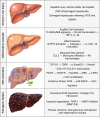From signaling pathways to clinical trials: mesenchymal stem cells as multimodal regenerative architects in liver cirrhosis therapy
- PMID: 40764597
- PMCID: PMC12326728
- DOI: 10.1186/s13287-025-04535-8
From signaling pathways to clinical trials: mesenchymal stem cells as multimodal regenerative architects in liver cirrhosis therapy
Abstract
Liver cirrhosis, a chronic disease distinguished by extensive scarring in the liver, results in liver dysfunction and fatal complications such as portal hypertension and liver cancer. Although early interventions can retard or reverse early injury, advanced stages often call for liver transplantation-a therapy undermined by donor shortage and logistical setbacks. Emerging cell therapies, particularly those based on mesenchymal stem cells (MSCs), offer a novel approach to addressing these clinical needs. MSCs, self-renewing multipotent stromal cells, can differentiate into many cell types, including hepatocyte-like cells. Immune regulation, regenerative signaling, and anti-scarring effects are three mechanisms that underlie their therapeutic promise. MSCs modulate immune cells, suppressing inflammation and promoting tissue healing. MSCs release several growth factors and cytokines, including hepatocyte growth factor (HGF), vascular endothelial growth factor (VEGF), epidermal growth factor (EGF), and matrix metalloproteinases (MMPs), which participate in tissue regeneration. Among these, HGF is bivalent, as it supports hepatocyte proliferation while also inhibiting fibrosis and apoptosis, thereby allowing the tissue to repair and protect itself. Recent advances identify extracellular vesicles from MSCs (MSC-EVs) as a cell-free alternative. The vesicles contain bioactive cargo, including microRNAs and proteins, that regulate immune function, inhibit cell death, and facilitate liver repair. Preclinical models of cirrhosis in animals have demonstrated MSC-EVs to enhance liver function, reduce scarring, and improve survival. This review integrates current knowledge of MSC-based therapies, their mechanisms, clinical potential, and challenges associated with their deployment. More than 50 clinical trials are registered or planned to evaluate MSC-based treatments for liver cirrhosis. Preclinical and clinical outcomes are encouraging; however, further work is needed to optimize delivery strategies, confirm safety, and facilitate the universal clinical use of this approach. Advances in MSC-guided regenerative medicine have the potential to revolutionize therapy for end-stage liver disease, offering hope where traditional treatments fail.
Keywords: Liver cirrhosis; MSC; MSC-EVs; Mesenchymal stem cells.
© 2025. The Author(s).
Conflict of interest statement
Declarations. Ethics approval and consent to participate: Ethical approval was not required. Consent for publication: We have no restrictions for publishing this review. Competing interests: The authors declare no competing interests.
Figures




Similar articles
-
New advances of NG2-expressing cell subset in marrow mesenchymal stem cells as novel therapeutic tools for liver fibrosis/cirrhosis.Stem Cell Res Ther. 2024 Jul 6;15(1):199. doi: 10.1186/s13287-024-03817-x. Stem Cell Res Ther. 2024. PMID: 38971781 Free PMC article.
-
Hepatocyte growth factor facilitates the repair of spinal cord injuries by driving the chemotactic migration of mesenchymal stem cells through the β-catenin/TCF4/Nedd9 signaling pathway.Stem Cells. 2024 Nov 5;42(11):957-975. doi: 10.1093/stmcls/sxae055. Stem Cells. 2024. PMID: 39269318
-
Management of urinary stones by experts in stone disease (ESD 2025).Arch Ital Urol Androl. 2025 Jun 30;97(2):14085. doi: 10.4081/aiua.2025.14085. Epub 2025 Jun 30. Arch Ital Urol Androl. 2025. PMID: 40583613 Review.
-
Mesenchymal stromal cells-derived extracellular vesicles in cartilage regeneration: potential and limitations.Stem Cell Res Ther. 2025 Jan 23;16(1):11. doi: 10.1186/s13287-025-04135-6. Stem Cell Res Ther. 2025. PMID: 39849578 Free PMC article.
-
Endothelial cell-derived extracellular vesicles modulate the therapeutic efficacy of mesenchymal stem cells through IDH2/TET pathway in ARDS.Cell Commun Signal. 2024 May 27;22(1):293. doi: 10.1186/s12964-024-01672-0. Cell Commun Signal. 2024. PMID: 38802896 Free PMC article.
References
-
- Sharma B, John S. Hepatic cirrhosis. 2018. - PubMed
-
- Asrani SK, Devarbhavi H, Eaton J, Kamath PS. Burden of liver diseases in the world. J Hepatol. 2019;70(1):151–71. - PubMed
-
- Ginès P, Krag A, Abraldes JG, Solà E, Fabrellas N, Kamath PS. Liver cirrhosis. Lancet. 2021;398(10308):1359–76. - PubMed
-
- Merli M, Nicolini G, Angeloni S, Rinaldi V, De Santis A, Merkel C, et al. Incidence and natural history of small esophageal varices in cirrhotic patients. J Hepatol. 2003;38(3):266–72. - PubMed
Publication types
MeSH terms
LinkOut - more resources
Full Text Sources
Medical
Miscellaneous

